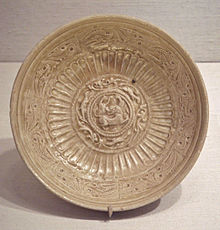- Northern Zhou
-
Zhou
周← 
←
557–581  →
→Capital Chang'an Government Monarchy Emperor - 557 Emperor Xiaomin of Northern Zhou - 557-560 Emperor Ming of Northern Zhou - 560-578 Emperor Wu of Northern Zhou - 578-579 Emperor Xuan of Northern Zhou - 579-581 Emperor Jing of Northern Zhou History - Established 15 February[1] 557 - Disestablished 4 March[2] 581 The Northern Zhou Dynasty (Chinese: 北周朝; pinyin: Bĕi Zhōu Cháo) followed the Western Wei, and ruled northern China from 557 to 581. It was overthrown by the Sui Dynasty.
Northern Zhou's basis of power was established by Yuwen Tai, who was paramount general of Western Wei, following the split of Northern Wei into Western Wei and Eastern Wei in 535. After Yuwen Tai's death in 556, Yuwen Tai's nephew Yuwen Hu forced Emperor Gong of Western Wei to yield the throne to Yuwen Tai's son Yuwen Jue (Emperor Xiaomin), establishing Northern Zhou. The reigns of the first three emperors (Yuwen Tai's sons) -- Emperor Xiaomin, Emperor Ming, and Emperor Wu were dominated by Yuwen Hu, until Emperor Wu ambushed and killed Yuwen Hu in 572 and assumed power personally. With Emperor Wu as a capable ruler, Northern Zhou destroyed rival Northern Qi in 577, taking over Northern Qi's territory. However, Emperor Wu's death in 578 doomed the state, as his son Emperor Xuan was an arbitrary and violent ruler whose unorthodox behavior greatly weakened the state. After Emperor Xuan's death in 580 (when he was already titularly retired emperor (Taishang Huang), Emperor Xuan's father-in-law Yang Jian seized power, and in 581 seized the throne from Emperor Xuan's son Emperor Jing, establishing Sui. The imperial Yuwen clan, including the young Emperor Jing, was subsequently slaughtered by Yang Jian.
Contents
Emperors of Northern Zhou
Posthumous Names (Shi Hao 諡號) Born Names Period of Reigns Era Names (Nian Hao 年號) and their according range of years Northern dynasty Northern Zhou Dynasty 557-581 Convention: Northern Zhou + posthumous name Xiao Min Di (孝閔帝 xiào mǐn dì) Yuwen Jue (宇文覺 yǔ wén jué) 557 Did not exist Ming Di (明帝 míng dì) or Xiao Ming Di (孝明帝 xiào míng dì) Yuwen Yu (宇文毓 yǔ wén yù) 557-560 Wucheng (武成 wǔ chéng) 559-560 Wu Di (武帝 wǔ dì) Yuwen Yong (宇文邕 yǔ wén yōng) 561-578 Baoding (保定 bǎo dìng) 560-565
Tianhe (天和 tiān hé) 566-572
Jiande (建德 jiàn dé) 572-578
Xuanzheng (宣政 xuān zhèng) 578Xuan Di (宣帝 xuān dì) Yuwen Yun (宇文贇 yǔ wén yūn) 578-579 Dacheng (大成 dà chéng) 579 Jing Di (靜帝 jìng dì) Yuwen Chan (宇文闡 yǔ wén chǎn) 579-581[3] Daxiang (大象 dà xiàng) 579-581
Dading (大定 dà dìng) 581Notes
- ^ Zizhi Tongjian, vol. 167.
- ^ Zizhi Tongjian, vol. 175.
- ^ In 580, after Emperor Xuan's death, the general Yuchi Jiong, believing that the regent Yang Jian was about to seize the throne, rose against Yang and declared a son of Emperor Wu's brother Yuwen Zhao (宇文招) the Prince of Zhao, whose name is lost to history, emperor, but as Yuchi was soon defeated, and nothing further was known about the emperor that he declared, that son of Yuwen Zhao is usually not considered an emperor of Northern Zhou.
References
See also
- Chinese history
- Southern and Northern Dynasty
- Chinese sovereign
Southern and Northern Dynasties (420–589) Northern dynasties Southern dynasties Categories:- Former monarchies of Asia
- Former countries in Chinese history
- Former empires
- States and territories established in 557
- States and territories disestablished in 581
- Northern Zhou
- 557 establishments
- 581 disestablishments
Wikimedia Foundation. 2010.


